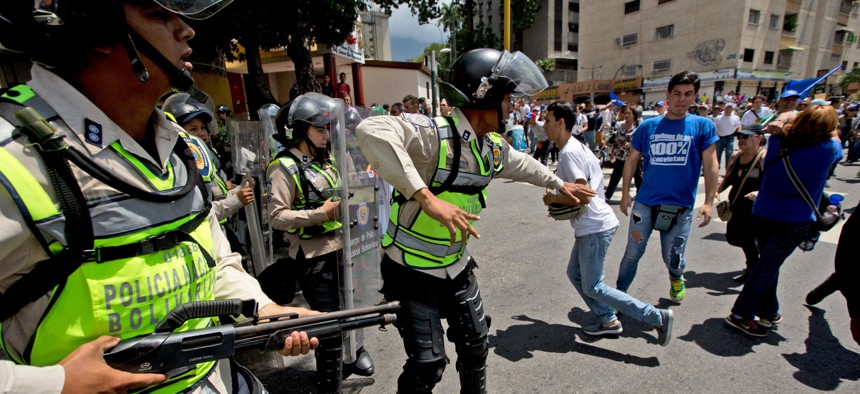
Bolivarian National Police officer try to disperse demonstrators during an opposition protest in Caracas, Venezuela, Friday, Sept. 16, 2016. Fernando Llano/AP
The CIA Says It Can Predict Social Unrest as Early as 3 to 5 Days Out
The reason: a dramatic improvement in analytics, cloud computing and ‘deep learning.’
What a difference 12 months can make.
Last year around this time, CIA stood up its first new office since 1963—the Directorate for Digital Innovation—a seismic shift for the agency that legitimized the importance of technology, including big data and analytics.
According to Deputy Director for Digital Innovation Andrew Hallman, the man tapped by CIA Director John Brennan to run the digital wing, that digital pivot is paying off.
The agency, Hallman said, has significantly improved its “anticipatory intelligence,” using a mesh of sophisticated algorithms and analytics against complex systems to better predict the flow of everything from illicit cash to extremists around the globe. Deep learning and other forms of machine learning can help analysts understand how seemingly disparate data sets might be linked or lend themselves to predicting future events with national security ramifications.
While intelligence analysts have access to CIA’s own classified data stores to sift through, they’re also increasingly turning to open data sets, which Brennan has said this summer have turned into a “tremendous advantage” for the agency.
“We have, in some instances, been able to improve our forecast to the point of being able to anticipate the development of social unrest and societal instability some I think as near as three to five days out,” said Hallman, speaking Tuesday at The Next Tech event hosted by Government Executive and Nextgov. The event is a part of the four-day Fedstival, which aims to look at “what's next” for the federal government in technology and management.
“What we’re trying to do within a unit of my directorate is leverage what we know from social sciences on the development of instability, coups and financial instability, and take what we know from the past six or seven decades and leverage what is becoming the instrumentation of the globe,” Hallman added.
Think of it like James Bond beefing up his arsenal over the decades. In the 1960s, 007 carried around his trusty Walther PPK and not much else. By 2015’s "Spectre," Bond wears an implanted transmitter, uses a laser microphone and accesses an automated surveillance technology system that vacuums up all sources of intelligence. Of course, he still has that classic Walther PPK—it’s now outfitted with an optical palm reader, so only Bond can fire it.
CIA's transformation is about agents in the field who “have more agility and understanding of digital awareness.” The agency also employs cloud computing and other technologies to make sense of growing amounts of data.
And that’s better for analysts and operatives as well as the policymakers they inform, Hallman said.
Whereas policymakers and key leadership have held decades-long confidence in intelligence attained from traditional spycraft, Hallman said until recently, it was “much harder to convey confidence for the policymaker who may make an important decision from advanced analytics with deep learning algorithms.”
However, with the inception of the digital directorate, that’s changed. Hallman said analysts are “becoming more proficient in articulating” observations to policymakers derived in these new ways. What it adds up to, Hallman said, is a clearer picture of events unfolding—or about to unfold—in an increasingly unclear world.



